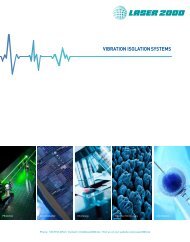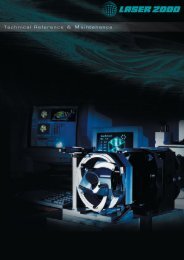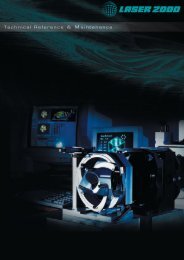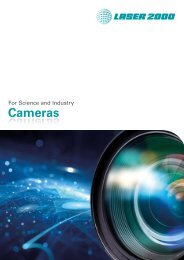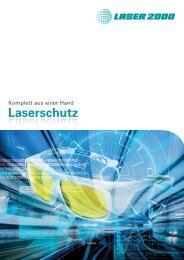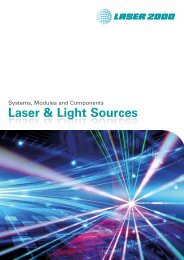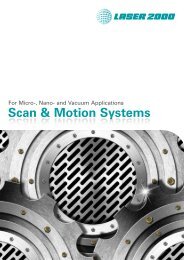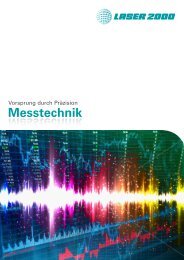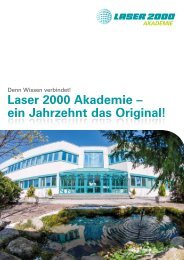Semrock Master Catalog 2018
Semrock Master Catalog 2018
Semrock Master Catalog 2018
You also want an ePaper? Increase the reach of your titles
YUMPU automatically turns print PDFs into web optimized ePapers that Google loves.
Edge Steepness and Transition Width<br />
<strong>Semrock</strong> edge filters – including our steepest RazorEdge ® Raman filters as<br />
well as our EdgeBasic filters for application-specific Raman systems and<br />
fluorescence imaging – are specified with a guaranteed “Transition Width.”<br />
Transition Width = maximum allowed spectral width between the laser line<br />
(where OD > 6) and the 50% transmission point<br />
Any given filter can also be described by its “Edge Steepness,” which is the<br />
actual steepness of the filter, regardless of the precise wavelength placement<br />
of the edge.<br />
Edge Steepness = actual steepness of a filter measured<br />
from the OD 6 point to the 50% transmission point<br />
Figure 1 illustrates Transition Width and Edge Steepness for an edge<br />
filter designed to block the 785 nm laser line (example shows a U-grade<br />
RazorEdge filter). Table 1 below lists the guaranteed Transition Width and<br />
typical Edge Steepness (for 25 mm diameter parts) for <strong>Semrock</strong> edge filters.<br />
All RazorEdge filters provide exceptional steepness to allow measurement<br />
of signals very close to the blocked laser line with high signal-to-noise ratio.<br />
However, the state-of-the-art E-grade RazorEdge filters take closeness to<br />
an Extreme level.<br />
The graph at the right illustrates that U-grade RazorEdge filters have a<br />
transition width that is 1% of the laser wavelength. E-grade filters have a<br />
Transition width that is twice as narrow, or 0.5% of the laser line!<br />
Table 1<br />
PRODUCT NOTE<br />
Edge Filter Type<br />
TECHNICAL NOTE<br />
Guaranteed Transition<br />
Width<br />
(% of laser wavelength)<br />
Ultraviolet (UV) Raman Spectroscopy<br />
Raman spectroscopy measurements generally face two<br />
limitations: (1) Raman scattering cross sections are tiny,<br />
requiring intense lasers and sensitive detection systems just<br />
to achieve enough signal; and (2) the signal-to-noise ratio is<br />
further limited by fundamental, intrinsic noise sources like<br />
sample autofluorescence. Raman measurements are most<br />
commonly performed with green, red, or near-infrared (IR)<br />
lasers, largely because of the availability of established lasers<br />
and detectors at these wavelengths. However, by measuring<br />
Raman spectra in the ultraviolet (UV) wavelength range, both<br />
of the above limitations can be substantially alleviated.<br />
Visible and near-IR lasers have photon energies below the<br />
first electronic transitions of most molecules. However, when<br />
the photon energy of the laser lies within the electronic<br />
spectrum of a molecule, as is the case for UV lasers and<br />
most molecules, the intensity of Raman-active vibrations can<br />
increase by many orders of magnitude – this effect is called<br />
“resonance-enhanced Raman scattering.”<br />
Although UV lasers tend to excite strong autofluorescence,<br />
it typically occurs only at wavelengths above about 300 nm,<br />
Typical Edge<br />
Steepness<br />
(% of laser wavelength)<br />
RazorEdge E-grade < 0.5% (< 90 cm -1 for 532) 0.2% (1.1 nm for 532)<br />
RazorEdge U-grade < 1.0% (< 186 cm -1 for 532) 0.5% (2.7 nm for 532)<br />
EdgeBasic < 2.5% (< 458 cm -1 for 532) 1.5% (8.0 nm for 532)<br />
* except UV filters<br />
Signal<br />
Laser<br />
Line<br />
Transmission (% and OD)<br />
100%<br />
50%<br />
10%<br />
OD 1<br />
OD 2<br />
OD 3<br />
OD 4<br />
OD 5<br />
OD 6<br />
780 785 790<br />
795 800<br />
Raman<br />
Signal<br />
Laser<br />
Line<br />
Transition<br />
Width<br />
Edge<br />
Steepness<br />
Wavelength (nm)<br />
Figure 1: Transition width and edge steepness illustrated.<br />
Transmission (% and OD)<br />
80 0 -80<br />
-160 -240<br />
100%<br />
50%<br />
10%<br />
OD 1<br />
OD 2<br />
OD 3<br />
OD 4<br />
OD 5<br />
Wavenumber Shift from 785 nm (cm –1 )<br />
E-grade<br />
~ 0.2%<br />
U-grade<br />
0.5% 1.0%<br />
~ 0.5%<br />
OD 6<br />
780 785 790<br />
795 800<br />
Wavelength (nm)<br />
Figure 2: Transition widths and edge steepnesses for<br />
LP02-785RE and LP02-785RU filters (see page 94).<br />
Autofluorescence<br />
Noise<br />
200 225 250 275 300 325 350 375 400<br />
Wavelength (nm)<br />
independent of the UV laser wavelength. Since even<br />
a 4000 cm –1<br />
(very large) Stokes shift leads to Raman<br />
emission below 300 nm when excited by a common 266<br />
nm laser, autofluorescence simply does not interfere<br />
with the Raman signal making high signal-to-noise ratio<br />
measurements possible.<br />
An increasing number of compact, affordable, and highpower<br />
UV lasers have become widely available, such as<br />
quadrupled, diode-pumped Nd:YAG lasers at 266 nm<br />
and NeCu hollow-cathode metal-ion lasers at 248.6 nm,<br />
making ultra-sensitive UV Raman spectroscopy a now<br />
widely accessible technique.<br />
NIR Filters Mirrors Polarizers<br />
Edge<br />
Filters<br />
Dichroic<br />
Beamsplitters<br />
Laser-line<br />
Filters<br />
Laser Diode<br />
Filters<br />
Notch<br />
Filters<br />
Lamp Clean-up<br />
Filters<br />
93<br />
More



